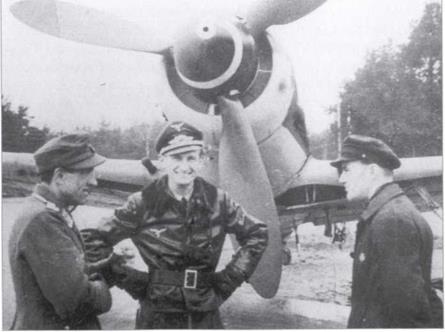Yesterday s Aircraft
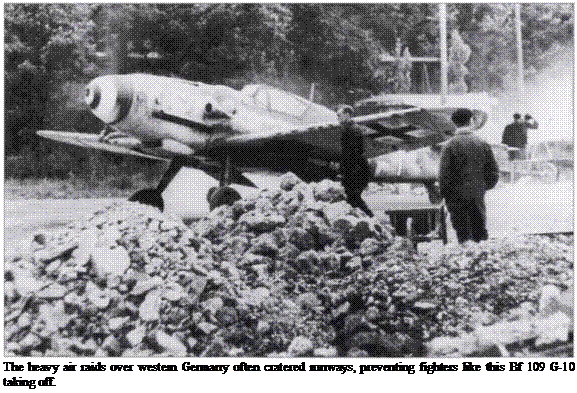 |
From a numerically very inferior position Luftwaffe pilots attacked Allied fighter and bomber formations over the Reich without regard to their own lives and despite increasing heavy losses. Aiter an initial daylight raid on Wilhelmshaven in January 1943 by 55 B-17 bombers, air raids by the Eighth AF became more frequent. On 28 July 1943 its bombers attacked the Fieseler aircraft works at Kassel and the important industrial centre of Magdeburg. Many more examples of carpet bombing were to follow until Germany lay in rubble.
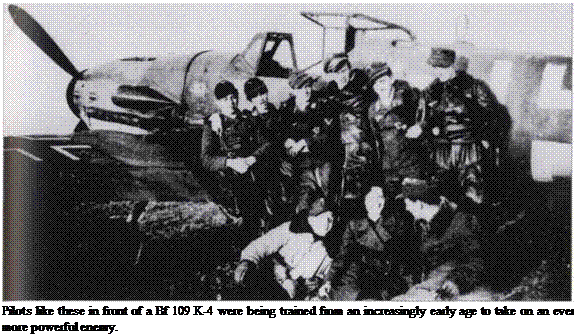
Although the defences scored significant victories against raiders over Schweinfurt and Nuremberg, the immensity of the enemy potential was only too obvious, and the Luftwaffe leadership was forced to recognise that more efficient fighters were urgendy needed. At the time availability was limited to the Bf 109 G-6.
On 14 October 1943 German defenders shot down 77 of 291 Allied machines attacking the important ball-bearing factories at Schweinfurt, but more major attacks on industrial centres were soon having their effect. The number of fighters could only be maintained with difficulty. As a rule the air defences were only successful in daylight engagements against bombers crossing the Reich to distant targets without a fighter escort. This changed within a few months when, from the beginning of 1944, P-51 Mustang long-range fighters began to escort Eighth AF bomber fleets. As a result of the mass of bombers arriving by day and night, the Reich fighter force continued to decline. The Bf 109 G-6 standard fighters with which most fighter Staffeln were equipped were increasingly used in the role of pursuer, and were prevented by numerous escort fighters from reaching their objective, the bombers. Of the long awaited Me 262 A-la jets there was still no sign. The general development, especially of turbines, had progressed slower than anticipated, and OKL now expected the aircraft to be available in reasonable
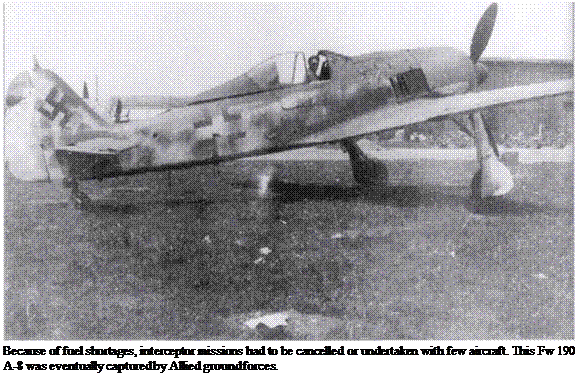 |
numbers from August 1944. The Bf 109 and Fw 190 therefore remained indispensable for the air defence of Germany until the end.
In 1943 and 1944 the Bf 109 G provided the backbone of the defence by day. This variant was the high point of the breed. Better performance than with the Bf 109 G-10 and G-14 was not to be expected, and since the development of substantially more efficient engines could not reach the hoped-for level, the emergency solution became urgent. The Daimler Benz DB 605L was suitable for both the Fw 190 and Bf 109 but it remained on the test stand and was a long way from series production. As an alternative an attempt was made to improve the DB 605 AS and DB 605 D by the use of a supplementary fuel injection system which it was hoped would provide the Bf 109 G with a slight advantage over the P-51 fighter.
The Bf 109 К was the last of the series to appear in quantity. The design office had chosen the DB 605 L engine with two-stage supercharger to provide a ceiling of about 9,500 metres (31,000 ft) at full pressure, but work was still proceeding to perfect it. The final mass-production programme had been started
at the end of 1942, but not until 1944 were a few fighter Gruppen equipped with this variant. The highly experienced engineer Ludwig Bolkow handled the proceedings from start to finish. The Bf 109 K, together with a fine tuning of other G-variants, was to become the new standard piston-engined fighter. To avoid any risks ten prototypes were ordered on 9 August 1943 to run a brief period of tests. A mock-up was built to check and evaluate all weapons and radio equipment and other components.
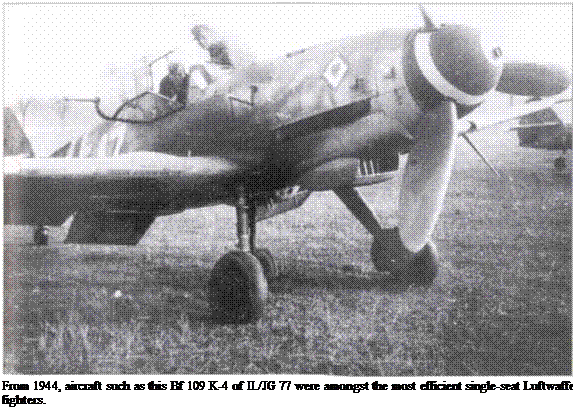 |
Allied air reconnaissance had detected that the WNF Works at Wiener Neustadt in Austria was one of the most important production plants for piston – engined fighters, and on 13 August US bombers attacked the factory. Some 500 workers were killed. Although assembly work was set back for a long period, numerous drawings, plans and assembly files were saved. By the end of 1944, the entire works had been relocated in the Burgenland. The WNF assembly plant, subsidiaries and numerous other firms were co-opted for fighter production, and a number of‘final assembly circuits’ set up in the Vienna-Wiener Neustadt – St Polten area, in Karnten, in the so-called Czech Protectorate and Hungary. Some of the work, such as the railway tunnel Objekt 217 B-C atTischnowitz in
the Protectorate was given a protective roof and turned out the Bf 109 in series production without fear of Allied bombing.
Meanwhile a full-size mock-up for the future Bf 109 K-l had been built by the WNF development team located near the bombed-out plant, and was ready in basic outline in September 1943. On 1 October 1943 the improved G-fuselage was presented to representatives of the KdE and closely inspected. Only a few minor details needed to be improved by WNF. Orders to implement full production of the Bf 109 K-l followed the final inspection of the wooden mock – up on 12 October 1943.
A Bf 109 G-6 (Works No. 18136 BF+QH) from the Erla production line was fitted with a modified airframe and engine for initial test purposes. The early Bf 109 К differed from previous variants by its use of wooden parts, such as for the tail section designed by Wolf Hirth GmbH of Nabern/Teck, and a more powerful engine, the DB 605 AS or D with MW 50 unit. Under licence to the Messerschmitt Works, Hirth GmbH developed wooden wings with integral MK 108 cannon but both here and in the tailplane there were structural problems to be overcome. While building the prototypes it was found that the technology was uneconomic because of the expense in working metal and wood, while a wooden undercarriage was deemed unsuitable for a high performance piston – engined fighter. The crash tests at Augsburg led to the scrapping of the remaining prototype wings and tooling. Shortly before the year’s end the contract for 3,995 pairs of wooden wings was cancelled in favour of the usual metal wings for better stability.
At the beginning of 1944 more talks were held regarding the installation of the MW 50 and GM-1 systems in the fuselage. These systems had been checked with regard to finding a simplified method of construction, and tested by specialists from the Rechlin and Tarnewitz test centres. During the conference with GLZM Milch on 2 March 1944 the continuation of Bf 109 G production and large-scale introduction of the Bf 109 К were discussed.
Whether the initial run of the К variant would be proceeded with was uncertain from the summer of 1944 after Messerschmitt had presented the first plans for the Bf 109 K-4. During the conference of 3 and 4 October 1944 chaired by engineer Roluf Lucht, it was claimed that the series-produced Bf 109 K-4 would be 35 km/hr (22 mph) faster than the later Bf 109 G versions, and accordingly it was decided to stop or cancel some Bf 109 G and К production lines since it was not known when major deliveries of the Me 262 were to be expected. Only the faster Bf 109 models would now have a chance of mass production. The first cancellation was the Bf 109 K-l, a single-seat fighter with the MK 108 cannon, deleted before the July 1944 planned run. The K-2 was also sacrificed because production of its MK 108 and MG 151/20 cannon at Posen (Poznan) was falling and the manufacturer could not meet production targets.
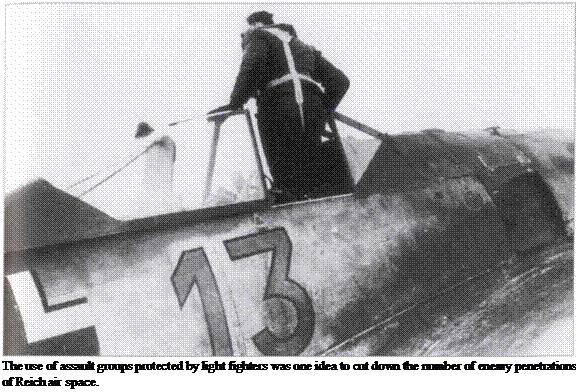 |
It had been intended to initiate a parallel mass-production run at Erla near Leipzig and in the Messerschmitt works at Regensburg from February 1944, and WNF was to begin production of the new fighter as from April 1944 using a less powerful version of the DB 605 than the L type. After opting for the more powerful Bf 109 K-4, the RLM cancelled the K-2, of which only a single model existed. This machine had served as a trial model for the wooden wings made by Hirth GmbH. The K-2 (Works No. 600056) had an MK 108 gun and was tested at Tarnewitz in the late summer of 1944. The machine was delivered without fixed aileron rods and was grounded after the first flight.
The Bf 109 K-4 was a mass-produced ‘light fighter’with a 9.92 metre (32 ft 6 in) wingspan. Its length was 9.01 metres (29 ft 7 in). Most machines of this type had a DB 605 DCM engine. The right-handed airscrew was manufactured by VDM and had an electro-mechanical auto unit which adapted revolutions to load pressure. Engineers expected a larger reserve at higher speeds by enlarging the cooling system, thus delaying overheating the DB 605 and promising an increase in speed of 15-20 km/hr (9-12.5 mph).
The Bf 109 K-4 had an FuG 16 ZY homing receiver with target acquisition and friend-or-foe FuGa recognition unit. Two MG 131 13-mm guns each with
|
As here at 4./JG 301 Stendal, high performance fighters such as the Fw 190 D-9 were used in increasingly large numbers. |
300 rounds fired through the propeller arc. The 30-mm MK 108 motorised cannon had 65 rounds. The former Revi 16B gunsight was to be replaced by the futuristic gyro-stabilised EZ 42 at the instigation of the Chief-TLR. The first prototype Bf 109 K-4 had an MG 151/20 instead of the MK 108. This machine (Works No. 330112) was completed at Regensburg in October 1944 and shown to KdE representatives who had arrived from Tarnewitz. Afterwards it was to be flown there, but the pilot was forced to make an emergency landing at Brandis with a defect in the cooling system and the machine remained there for some time for lack of spares.
On 30 November 1944 OKL assembled a number of high-performance aircraft including the Bf 109 K-4 at Rechlin. Because the test centre was overwhelmed with more important projects, particularly jets, KdE only carried out basic tests of the K-4 and held back on the weapons testing. It was proposed to combine the trials with those of the K-6, and investigation of the speed potential, the streamlined upper wing design and other modifications were also postponed even though Oberst Edgar Petersen of KdE predicted that the modifications would make the K-4 50-60 km/hr (30-40 mph) faster. The other advantage of the K-4 was that from the outset only tried and tested components had been used, so that long drawn out trials were not necessary.
Immediately after the initial trial the first Bf 109 K-4s were delivered to III./JG 27 in October 1944. The first was lost on 19 October 1944 during delivery. The first engagements occurred at the beginning of November and shortly afterwards IV./JG 27, III./JG 4 and III./JG 77 all received their first K-4s. The K-4 variant with the pressurised cabin requested by pilots and Milch was never provided because the alterations were too expensive.
By the beginning of 1945 the development of the Bf 109 K-6 was relatively well advanced. This variant of‘Karl’was on the WNF drawing boards in the summer of 1944 and was designed to be better armed than the K-4. Besides the two MG 131s it was planned to carry an MK 109 gun together with two MK 108s or MG 151/20s in the wings. A section of the new wing was tried out on a Bf 109 G-6 atTarnewitz on the test stand and in flight. After a number of problems had been resolved, at the end of October 1944Tarnewitz gave the go – ahead for weapons to be mounted in February 1945. Soon afterwards the provisional machine received an EZ 41 reflector gunsight and was released to 1. Flieger-Division for trials on operations with a fighter unit. The performance calculations for the Bf 109 K-6 with DB 605 ASCM/DCM engines worked out at 600 km/hr (372 mph) near ground level and 730 km/hr at 8,000 metres (454 mph at 26,250 ft), but data recorded for a similarly equipped machine were restricted to 530 km/hr and 700 km/hr (330 and 435 mph) respectively. Operational ceiling was calculated to be 12,500 metres (41,000 ft), range about 575 kilometres (360 miles).
It was planned to produce the Bf 109 K-6 in reasonable numbers in the Wiener Neustadt area with the new weapons as from the summer of 1945. The Bf 109 K-4 was to be manufactured at Regensburg and Leipzig. The Messerschmitt Works offered the Bf 109 K-8 as a single-seat short range reconnaissance aircraft. This was welcomed at once by General von Barsewisch, the head of air reconnaissance, as a ‘fast reconnaissance machine with pressure cabin, and met the performance specifications set on 20 January 1944 replacing the Bf 109 G-8, which had meanwhile been judged to be under-powered. An Rb 50/30 camera unit was to be fitted in the fuselage and a BSK camera below the wings. According to the blueprints the Bf 109 K-8 was designed to have an additional 300-litre tank and an MK 108 cannon. No other weapons were planned, in order to keep the weight down. Whether a K-8 prototype was built by the beginning of 1945 is unlikely. Even the Bf 109 K-10, a fighter equipped with two MK 103s in the wing roots, never left the planning stage because the heavy 30-mm guns would not be available in sufficient quantity and were needed more urgently for the Do 335 В Jabo.
Due to problems of supply caused by air raids on industry and the collapsing infrastructure, all manufacturers of the Bf 109 K-4 encountered serious difficulties. Even so, from the end of 1944 the Messerschmitt line set up at
Regensburg in September was well into production, though only after several weeks’delay because of modifications made to the tailplane. Most of the Bf 109 K-4s produced were assembled and flight-tested at Regensburg. By 31 December 1944 857 machines had left the final assembly area, including 221 in November 1944 and 325 the following month. This was only possible using coundess PoWs, foreign labourers and concentration camp inmates. In the nine months to October 1944, more than 80 Bf 109s, about 10 per cent of production, were lost in crashes attributed to sabotage during test and delivery flights.
From 1 January 1945 to 25 April, when American ground forces reached the Danube at Regensburg, more than 300 Bf 109 K-4s were completed there. Some production was also achieved until March at Vilseck and Cham. Most of Bf 109 K-4s had works numbers between 330105 and 335210. In all, 10,888 Bf 109s were built at Regensburg of which barely 900 were К-versions, far fewer than planned. In mid-April the Bf 109 K-4 was to be found at the following units:
a) III./JG 3: 47 K-4s and G-14s. (Major Karl-Heinz Langer: Luftflotte Reich).
b) III./JG 4: 61, plus Bf 109 G-14s and K-14s. (Hauptmann Gerhard Strasen).
c) II. and III./JG 27: 48 assorted Bf 109s (Luftwaffenkommando West).
d) Stab, I. and II./JG 52: 91 Bf 109 G-14s and K-4s. (Oberst Hermann Graf, Luftflotte 6, East Front).
e) III./JG 53: 40 K-4s of which 24 were operational (Hauptmann Siegfried Luckenbach).
f) Three Gruppen of JG 77:100 Bf 109s on 9 April 1945 including Bf 109 G-14s and K-4s of which 81 were operational despite the precarious fuel situation although few flights were possible.











